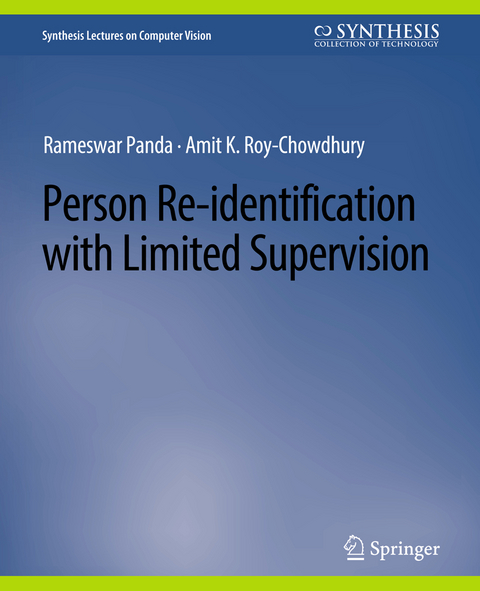
Person Re-Identification with Limited Supervision
Springer International Publishing (Verlag)
978-3-031-00697-5 (ISBN)
In this book, we provide an overview of some of the literature in person re-identification, and then move on to focus on some specific problems in the context of person re-identification with limited supervision in multi-camera environments. We expect this to lead to interesting problems for researchers to consider in the future, beyond the conventional fully supervised setup that has been the framework for a lot of work in person re-identification.
Chapter 1 starts with an overview of the problems in person re-identification and the major research directions. We provide an overview of the prior works that align most closely with the limited supervision theme of this book. Chapter 2 demonstrates how global camera network constraints in the form of consistency can be utilized for improving the accuracy of camera pair-wise person re-identification models and also selecting a minimal subset of image pairs for labeling without compromising accuracy. Chapter 3 presents two methods that hold the potential for developing highly scalable systems for video person re-identification with limited supervision. In the one-shot setting where only one tracklet per identity is labeled, the objective is to utilize this small labeled set along with a larger unlabeled set of tracklets to obtain a re-identification model. Another setting is completely unsupervised without requiring any identity labels. The temporal consistency in the videos allows us to infer about matching objects across the cameras with higher confidence, even withlimited to no supervision. Chapter 4 investigates person re-identification in dynamic camera networks. Specifically, we consider a novel problem that has received very little attention in the community but is critically important for many applications where a new camera is added to an existing group observing a set of targets. We propose two possible solutions for on-boarding new camera(s) dynamically to an existing network using transfer learning with limited additional supervision. Finally, Chapter 5 concludes the book by highlighting the major directions for future research.
Rameswar Panda obtained his Ph.D. in Electrical and Computer Engineering from University of California, Riverside. Prior to joining UC Riverside, he obtained his M.S. from Jadavpur University and B.E. from Biju Patnaik University of Technology, both in India. While studying for his Ph.D., Rameswar worked at NEC Labs America, Adobe Research, and Siemens Corporate Research. His primary research interests span the areas of computer vision, machine learning, and multimedia. In particular, his current focus is on making AI systems more efficient, i.e., developing novel deep learning methods that can operate with less human-annotated data (data efficient) and less computation (model efficient). He is also interested in image/video understanding, unsupervised/self-supervised representation learning, and multimodal learning (e.g., combining vision, sound/speech and language). His work has been published in top-tier conferences such as CVPR, ICCV, ECCV, NeurIPS, ICML, and ICLR, as well as high impact journals such as TIP and TMM. He actively participates as a program committee member for many top AI conferences and was leading co-chair of the workshop on Multi-modal Video Analysis at ICCV 2019, ECCV 2020 and Workshop on Neural Architecture Search at CVPR 2020, CVPR 2021.Amit K. Roy-Chowdhury received his Ph.D. from the University of Maryland, College Park(UMCP) in 2002 and joined the University of California, Riverside (UCR) in 2004 where he is a Professor and Bourns Family Faculty Fellow of Electrical and Computer Engineering, Director of the Center for Robotics and Intelligent Systems, and Cooperating Faculty in the department of Computer Science and Engineering. He leads the Video Computing Group at UCR, working on foundational principles of computer vision, image processing, and statistical learning, with applications in cyber-physical, autonomous, and intelligent systems. He co-directs the US Department of Defense Center of Excellence NC4: Networked, Configurable Command, Control and Communications for Rapid Situational Awareness. He has published over 200 papers in peer-reviewed journals and conferences, and he is the first author of the book Camera Networks: The Acquisition and Analysis of Videos Over Wide Areas. He is on the editorial boards of major journals and program committees of the main conferences in his area. His students have been first authors on multiple papers that received Best Paper Awards at major international conferences, including ICASSP and ICMR. He is a Fellow of the IEEE and IAPR, received the Doctoral Dissertation Advising/Mentoring Award 2019 from UCR, and the ECE Distinguished Alumni Award from UMCP.
Preface.- Person Re-identification: An Overview.- Supervised Re-identification: Optimizing the Annotation Effort.- Towards Unsupervised Person Re-identification.- Re-identification in Dynamic Camera Networks.- Future Research Directions.- Bibliography.- Authors' Biographies.
| Erscheinungsdatum | 06.06.2022 |
|---|---|
| Reihe/Serie | Synthesis Lectures on Computer Vision |
| Zusatzinfo | XI, 86 p. |
| Verlagsort | Cham |
| Sprache | englisch |
| Maße | 191 x 235 mm |
| Gewicht | 207 g |
| Themenwelt | Informatik ► Grafik / Design ► Digitale Bildverarbeitung |
| Informatik ► Theorie / Studium ► Künstliche Intelligenz / Robotik | |
| ISBN-10 | 3-031-00697-6 / 3031006976 |
| ISBN-13 | 978-3-031-00697-5 / 9783031006975 |
| Zustand | Neuware |
| Haben Sie eine Frage zum Produkt? |
aus dem Bereich


